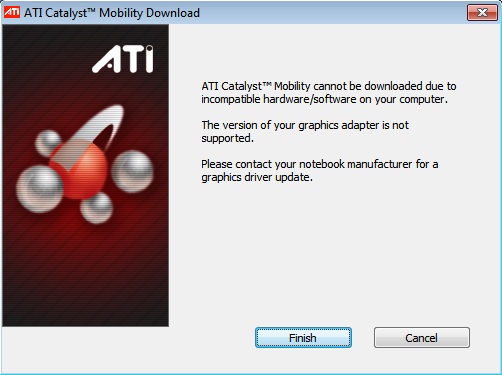Ladies and Gentleman,

This document provides the answers to frequently asked questions about AMD graphics drivers and software download and installation. Examples include; where to download drivers, and how to install graphics drivers. Home » ATI Radeon 3000 Graphics Use the links on this page to download the latest version of ATI Radeon 3000 Graphics drivers. All drivers available for download have been scanned by antivirus program.
This document provides the answers to frequently asked questions about AMD graphics drivers and software download and installation. Examples include; where to download drivers, and how to install graphics drivers.
I own a MacBook Pro 2011 A1286 which I got as a freebie from a friend who saved it from the corporate dumpster.
This machine as many of its generation was dumped because of a graphics fault. The discrete graphics in the laptop (AMD Radeon HD 6750M) is dead. Its a common fault in those machines and the users were offered a replacement - there was a special recall program which ended long before I got my hands on this laptop.
I am not a wealthy person and I love to tinker with the hardware. This laptop has a i7 cpu, 4 cores 8 threads, I've extended its memory to 8 GB and I keep trying to bring it back to life.
So far I've managed to use a EFI hack to disable the discrete AMD graphics. This is the script I have used while booted to Arch Linux live cd.
cd / &&

umount /sys/firmware/efi/efivars/ &&
mount -t efivarfs rw /sys/firmware/efi/efivars/ &&
cd /sys/firmware/efi/efivars/ &&
printf 'x07x00x00x00x01x00x00x00' > /sys/firmware/efi/efivars/gpu-power-prefs-fa4ce28d-b62f-4c99-9cc3-6815686e3
0f9 &&
chattr +i '/sys/firmware/efi/efivars/gpu-power-prefs-fa4ce28d-b62f-4c99-9cc3-6815686e30f9' &&
cd / &&
umount /sys/firmware/efi/efivars/ &&

reboot
What does it do? It tells the laptop to turn off discrete AMD graphics and to use Intel card. Thanks to this hack I was able to install MacOS Sierra, prepare space for unsupported on this laptop Windows 10 Professional 64 bit and then shrink the windows partiton and install Arch Linux 64 bit with Plasma desktop. Fun fun fun..Script needs to be re-run if PRAM was cleared so I saved it as /boot/FixAMD.sh in my ArchLinux. Refind allows me to switch between the installations without any problem.
MacOS runs okish. Few graphics glitches, not great performance. Linux runs fantastic. Its really working awesome.
Problem starts with Windows 10. For some reason Intel decided to abandon HD 3000 graphics and does not provide the drivers for Windows 10. No biggie. Found out that the GPU supposedly works great from the drivers from Windows update... Unfortunately this is not my experience.
I am installing Windows 10 Pro 64 bits using EFI boot, everything works great. Laptop finishes installation, I am allowed to log in to windows and I can see two basic graphics interfaces in the device manager.
I tried the Win7 64 bit driver, Win 8.1 64 bit driver, windows update driver. I tried installing the drivers before and after installing bootcamp for Windows 7. I tried installing AMD drivers first, Intel first, I tried disabling AMD graphics in the Device Manager, I tried setting up custom resolution... I tried many other things. I tried changing order of doing thins. Reinstalled fresh 20 - 30 times during the last 4 - 5 weekends.Tried installing stuff in different order, drivers first, Intel Drivers Update Utility + chipset firmware updated (inf) first, update fully first, different set of drivers as mentioned above. No matter what I do after installation of Intel HD 3000 graphics always ends up looking like this:
It is stretched, with maximum resolution 1280x800 (while the Intel HD 3000 card native res is 1860 x 1050), It looks like the screen is stretched beyond the LCD capabilities but I know its not true as I can get the native resolution working in MacOS and Linux.
I did a lot of research up to this point. Googled a lot, read a lot... I tried many solutions. Custom resolution, 3 different GPU drivers and so on... but this one - I cannot figure out. Can someone smarter than myself explain to me what am I doing wrong? Drivers for the Intel HD 3000 GPU always installed without any warning. No matter which of the mentioned above. Only during the GPU detection step the screen goes mad. I never forced any drivers. System accepted them as correct ones and then this happens...
- What is the proper procedure here... What I need is to install both cards AMD and Ati drivers and then disable AMD card so that Intel takes over. Correct?
- Is it possible that I need some special display driver? Maybe its the Macbook's LCD that is the culprit here and not GPU or its drivers?
- Have you ever faced such problem? What was the solution?
Thanks in advance for any help provided.
Integrated Ati Radeon™ Hd 3000 Gpu Driver
With regards.
Ati Radeon Hd 3000 Gpu Drivers For Mac Pro
AndrzejL